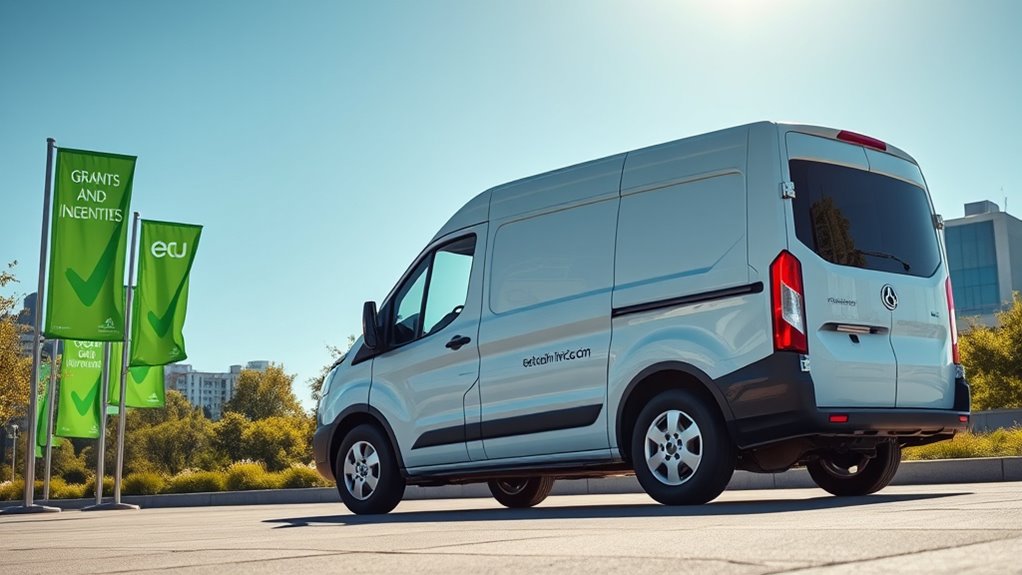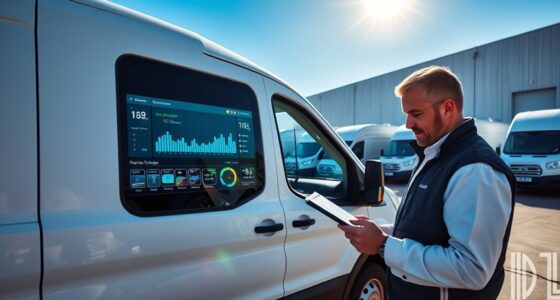If you’re considering electric vans, various incentives can lower your costs in the US and EU. In the US, federal tax credits from the Inflation Reduction Act, plus state-level rebates like California’s CVRP, can markedly cut your expenses. In Europe, countries like Germany, France, and the UK offer purchase grants, tax benefits, and toll exemptions. Supporting infrastructure incentives and quick access to these programs can maximize your savings—continue to explore these options for more details.
Key Takeaways
- US federal incentives like the Inflation Reduction Act offer substantial tax credits for qualifying electric vans, often overlapping with state rebates.
- US states such as California provide additional rebates and grants, boosting overall savings for EV van buyers.
- EU countries like Germany, France, and the UK offer direct purchase grants, tax benefits, and toll exemptions for electric vans.
- Incentives frequently include support for charging infrastructure, reducing operating costs and improving EV van practicality.
- Eligibility and application processes vary; acting quickly and staying updated ensures maximum benefit from available grants and incentives.

Are you aware of the financial incentives available for switching to electric vans? If you’re considering making the leap to electric commercial vehicles, understanding the various grants and incentives can substantially reduce your upfront costs. Both the US and the EU have introduced programs designed to encourage the adoption of electric vans, recognizing their benefits for the environment and your bottom line.
Financial incentives for electric vans can significantly lower your initial costs in the US and EU.
In the United States, federal programs like the Inflation Reduction Act have created compelling incentives. The Clean Vehicle Credit, for instance, offers substantial tax credits for qualifying electric vans, potentially covering a significant portion of your vehicle’s purchase price. These credits are designed to phase out for manufacturers once they reach certain sales thresholds, so it’s essential to check current eligibility.
Some states go further by offering additional rebates or incentives. California’s Clean Vehicle Rebate Project (CVRP), for example, provides rebates directly to consumers and businesses purchasing electric vehicles, including vans. Other states may provide grants or reduced registration fees, which can add up to considerable savings over time. It’s worth exploring local programs because they often complement federal initiatives, giving you more financial support.
Across the Atlantic, the European Union has also stepped up with a range of incentives aimed at boosting electric van adoption. Many EU countries offer direct purchase grants, which reduce the initial cost of electric vans. For example, Germany’s Umweltbonus scheme provides substantial subsidies to both individuals and businesses, making electric vans more accessible.
France and the UK (even post-Brexit) run similar programs, offering grants that can cover a significant part of the vehicle’s cost. Additionally, several countries provide tax benefits, lower registration fees, or exemptions from road tolls for electric vehicles. These incentives are part of broader national strategies to meet climate goals by phasing out internal combustion engines.
They often include support for charging infrastructure, making it easier and cheaper to operate your electric van. To maximize your benefits, you need to stay informed about the specific incentives available in your region and their eligibility criteria. Many programs are time-limited or have caps on the number of grants issued, so acting quickly can make a difference.
Moreover, understanding how these incentives work—whether they’re discounts applied at purchase, tax credits claimed later, or rebates—will help you plan your budget more effectively. Consulting with local dealers or government agencies can clarify the latest offers and guide you through the application process. Additionally, electric vehicle incentives are evolving rapidly, so staying updated is crucial for maximizing savings.
Frequently Asked Questions
Are There Specific Grants for Commercial Van Conversions?
Yes, there are specific grants for commercial van conversions. You can access federal, state, or local programs designed to support electric vehicle upgrades, including conversions. These grants often target businesses aiming to reduce emissions or promote sustainable transportation.
To find the right options, research regional initiatives and eligibility criteria, and consider working with organizations specializing in EV funding. Applying for these grants can substantially lower your conversion costs.
How Do Incentives Vary by Van Size and Weight Class?
Incentives often depend on your van’s size and weight class. Generally, smaller and lighter vans qualify for more generous grants, as they’re considered lower impact.
Larger, heavier vans may receive fewer incentives or face stricter requirements. You should check local programs, as thresholds vary by region, and some incentives are tailored to specific weight brackets.
Always verify current eligibility rules to maximize your benefits.
Can Leasing Affect Eligibility for EV Incentives?
Leasing can affect your eligibility for EV incentives, with about 50% of incentives available to leaseholders in some regions.
When you lease, the leasing company often claims the incentives, which mightn’t directly benefit you. However, some programs require the owner to be the registered owner on the title, so leasing can complicate eligibility.
Always check specific program rules before leasing to maximize your incentives.
Are There Income Restrictions for Van Incentives?
Yes, there are income restrictions for van incentives. Your eligibility often depends on your income level, with some programs targeting lower- to moderate-income individuals or households. These restrictions aim to promote equitable access to EV incentives and make sure they benefit those who need financial assistance most.
Check specific program guidelines in your area to determine if your income qualifies, as thresholds can vary by region and incentive type.
How Long Do Grant Application Processes Typically Take?
The grant application process usually takes anywhere from a few weeks to several months, depending on the program and your location.
You should prepare all required documents early and double-check eligibility criteria to avoid delays.
Stay in contact with the grant administrators, and follow up if needed.
Patience is key, as thorough reviews and processing times can extend the timeline, but being organized helps speed things up.
Conclusion
As you navigate the landscape of EV grants and incentives, remember they’re like keys revealing a brighter, cleaner future. Each opportunity isn’t just a financial boost but a symbol of progress—an open door to innovation and sustainability. Embrace these incentives as your guiding stars, lighting the path forward. With every van you electrify, you’re not just making a change; you’re shaping a legacy of hope and resilience for generations to come.









